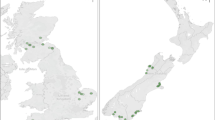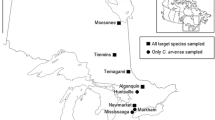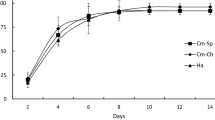Abstract
Exotic species more closely related to native species may be more susceptible to attack by native natural enemies, if host use is phylogenetically conserved. Where this is the case, the use of phylogenies that include co-occurring native and exotic species may help to explain interspecific variation in damage. In this study, we measured damage caused by pre-dispersal seed predators to common native and exotic plants in the family Asteraceae. Damage was then mapped onto a community phylogeny of this family. We tested the predictions that damage is phylogenetically structured, that exotic plants experience lower damage than native species after controlling for this structure, and that phylogenetically novel exotic species would experience lower damage. Consistent with our first prediction, 63% of the variability in damage was phylogenetically structured. When this structure was accounted for, exotic plants experienced significantly lower damage than native plants, but species origin only accounted for 3% of the variability of capitular damage. Finally, there was no support for the phylogenetic novelty prediction. These results suggest that interactions between exotic plants and their seed predators may be strongly influenced by their phylogenetic position, but not by their relationship to locally co-occurring native species. In addition, the influence of a species’ origin on the damage it experiences often may be small relative to phylogenetically conserved traits.



Similar content being viewed by others
References
Agrawal AA, Kotanen PM (2003) Herbivores and the success of exotic plants: a phylogenetically controlled experiment. Ecol Lett 6:712–715
Borcard D, Legendre P (2002) All-scale spatial analysis of ecological data by means of principal coordinates of neighbour matrices. Ecol Model 153:51–68
Brändle M, Brandl R (2006) Is the composition of phytophagous insects and parasitic fungi among trees predictable? Oikos 113:296–304
Cadotte MW, Hamilton MA, Murray BR (2009) Phylogenetic relatedness and plant invader success across two spatial scales. Divers Distrib 15:481–488
Cahill JF, Kembel SW, Lamb EG, Keddy PA (2008) Does phylogenetic relatedness influence the strength of competition among vascular plants? Perspect Plant Ecol 10:41–50
Cappuccino N, Carpenter D (2005) Invasive exotic plants suffer less herbivory than non-invasive exotic plants. Biol Lett 1:435–438
Chun YJ, van Kleunen M, Dawson W (2010) The role of enemy release, tolerance and resistance in plant invasions: linking damage to performance. Ecol Lett 13:937–946
Colautti RI, Ricciardi A, Grigorovich IA, MacIsaac HJ (2004) Is invasion success explained by the enemy release hypothesis? Ecol Lett 7:721–733
Crawley MJ (1989) Insect herbivores and plant population dynamics. Annu Rev Ecol Syst 34:531–564
Crawley MJ (2007) The R book. Wiley, New York
Daehler CC (2001) Darwin’s naturalization hypothesis revisited. Am Nat 158:324–330
Darwin C (1859) On the origin of species by means of natural selection. Murray, London
Dawson W, Burslem D, Hulme PE (2009) Herbivory is related to taxonomic isolation, but not to invasiveness of tropical alien plants. Divers Distrib 15:141–147
de Candolle ALP (1855) Géographie botanique raissoné. Masson, Paris
Desdevises Y, Legendre P, Azouzi L, Morand S (2003) Quantifying phylogenetically structured environmental variation. Evolution 57:2647–2652
Diez JM, Sullivan JJ, Hulme PE, Edwards G, Duncan RP (2008) Darwin’s naturalization conundrum: dissecting taxonomic patterns of species invasions. Ecol Lett 11:674–681
Diniz-Filho JAF, de Sant’Ana CER (1998) An eigenvector method for estimating phylogenetic inertia. Evolution 52:1247–1262
Duncan RP, Williams PA (2002) Darwin’s naturalization hypothesis challenged. Nature 417:608–609
Felsenstein J (1985) Phylogenies and the comparative method. Am Nat 125:1–15
Fenner M, Lee WG (2001) Lack of pre-dispersal seed predators in introduced Asteraceae in New Zealand. N Z J Ecol 25:95–99
Fenner M, Cresswell JE, Hurley RA (2002) Relationship between capitulum size and pre-dispersal seed predation by insect larvae in common Asteraceae. Oecologia 130:72–77
Frenzel M, Brandl R (2001) Hosts as habitats: faunal similarity of phytophagous insects between host plants. Ecol Entomol 26:594–601
Funk VA, Bayer RJ, Kelley S, Chan R, Watson L, Gemeinholzer B, Schilling E, Panero JL, Baldwin BG, Garcia-Jacas N, Susanna A, Jansen RK (2005) Everywhere but Antarctica: using a supertree to understand the diversity and distribution of the Compositae. Biol Skr 55:343–374
Gaskin JF, Wilson LM (2007) Phylogenetic relationships among native and naturalized Hieracium (Asteraceae) in Canada and the United States based on plastid DNA sequences. Syst Bot 32:478–485
Gilbert GS, Webb CO (2007) Phylogenetic signal in plant pathogen-host range. Proc Natl Acad Sci USA 104:4979–4983
Gross RS, Werner PA, Hawthorn WR (1980) The biology of Canadian weeds 38: Arctium minus (Hill) Bernh. and A. lappa L. Can J Plant Sci 60:621–634
Hawkes CV (2007) Are invaders moving targets? The generality and persistence of advantages in size, reproduction, and enemy release in invasive plant species with time since introduction. Am Nat 170:832–843
Hawthorn WD, Hayne PD (1978) Seed production and pre-dispersal seed predation in the biennial composite species, Arctium minus (Hill) Bernh. and A. lappa L. Oecologia 34:283–295
Hill SB, Kotanen PM (2009) Evidence that phylogenetically novel non-indigenous plants experience less herbivory. Oecologia 161:581–590
Hill SB, Kotanen PM (2010) Phylogenetically structured damage on Asteraceae: susceptibility of native and exotic species to foliar herbivores. Biol Invasions 12:3333–3342
Holt RD (1977) Predation, apparent competition, and structure of prey communities. Theor Popul Biol 12:197–229
Joshi J, Vrieling K (2005) The enemy release and EICA hypothesis revisited: incorporating the fundamental difference between specialist and generalist herbivores. Ecol Lett 8:704–714
Keane RM, Crawley MJ (2002) Exotic plant invasions and the enemy release hypothesis. Trends Ecol Evol 17:164–170
Kim KJ, Choi KS, Jansen RK (2005) Two chloroplast DNA inversions originated simultaneously during the early evolution of the sunflower family (Asteraceae). Mol Biol Evol 22:1783–1792
Levine JM, Adler PB, Yelenik SG (2004) A meta-analysis of biotic resistance to exotic plant invasions. Ecol Lett 7:975–989
Lewinsohn TM, Novotny V, Basset Y (2005) Insects on plants: diversity of herbivore assemblages revisited. Annu Rev Ecol Syst 36:597–620
Liu H, Stiling P (2006) Testing the enemy release hypothesis: a review and meta-analysis. Biol Invasions 8:1535–1545
Liu H, Stiling P, Pemberton RW (2007) Does enemy release matter for invasive plants? evidence from a comparison of insect herbivore damage among invasive, non-invasive and native congeners. Biol Invasions 9:773–781
Louda SM (1983) Seed predation and seedling mortality in the recruitment of a shrub, Haplopappus venetus (Asteraceae), along a climatic gradient. Ecology 64:511–521
Louda SM, O’Brien CW (2002) Unexpected ecological effects of distributing the exotic weevil, Larinus planus (F.), for the biological control of Canada thistle. Conserv Biol 16:717–727
Louda SM, Potvin MA (1995) Effect of inflorescence-feeding insects in the demography and lifetime fitness of a native plant. Ecology 76:229–245
Louda SM, Kendall D, Connor J, Simberloff D (1997) Ecological effects of an insect introduced for the biological control of weeds. Science 277:1088–1090
Louda SM, Pemberton RW, Johnson MT, Follett PA (2003) Nontarget effects—the Achilles’ heel of biological control? Retrospective analyses to reduce risk associated with biocontrol introductions. Annu Rev Entomol 48:365–396
Mack RN (1996) Predicting the identity and fate of plant invaders: emergent and emerging approaches. Biol Conserv 78:107–121
Maron JL, Vilà M (2001) When do herbivores affect plant invasion? Evidence for the natural enemies and biotic resistance hypotheses. Oikos 95:361–373
Mason PG, Huber JT (2002) Biological control programmes in Canada 1981–2000. CABI, Ottawa
Mitchell CE, Agrawal AA, Bever JD, Gilbert GS, Hufbauer RA, Klironomos JN, Maron JL, Morris WF, Parker IM, Power AG, Seabloom EW, Torchin ME, Vazquez DP (2006) Biotic interactions and plant invasions. Ecol Lett 9:726–740
Moore RJ (1975) The biology of Canadian weeds, 13. Cirsium arvense (L.) Scop. Can J Plant Sci 55:1033–1048
Morton JK, Venn JM (1990) A checklist of the flora of Ontario: vascular plants. University of Waterloo Biology Series 34, Waterloo, ON
Noyes RD (2000) Biogeographical and evolutionary insights on Erigeron and allies (Asteraceae) from ITS sequence data. Plant Syst Evol 220:93–114
Odegaard F, Diserud OH, Ostbye K (2005) The importance of plant relatedness for host utilization among phytophagous insects. Ecol Lett 8:612–617
Oksanen J, Kindt R, Legendre P, O’Hara B, Simpson GL, Solymos P, Stevens MHH, Wagner H (2009) vegan: community ecology package. R package version 1.15-4. http://CRAN.R-project.org/package=vegan
Parker IM, Gilbert GS (2007) When there is no escape: the effects of natural enemies on native, invasive, and noninvasive plants. Ecology 88:1210–1224
Parker JD, Hay ME (2005) Biotic resistance to plant invasions? Native herbivores prefer non-native plants. Ecol Lett 8:959–967
Pearse IS, Hipp AL (2009) Phylogenetic and trait similarity to a native species predict herbivory on non-native oaks. Proc Nat Acad Sci USA 106:18097–18102
SAS (2002) JMP. SAS Institute, Cary
Semple JC, Cook RE (2006) Solidago. In: Committee FNAE (ed) Flora of North America. Oxford University Press, Oxford, pp 107–166
Strauss SY, Webb CO, Salamin N (2006) Exotic taxa less related to native species are more invasive. Proc Natl Acad Sci USA 103:5841–5845
Strong DR, Lawton JH, Southwood R (1984) Insects on plants. Harvard University Press, Cambridge
R Development core team (2006) R: a language and environment for statistical computing. R foundation for statistical computing, Vienna, Austria. http://www.R-project.org
Thuiller W, Gallien L, Boulangeat I, de Bello F, Münkemüller T, Roquet C, Lavergne S (2010) Resolving Darwin’s naturalization conundrum: a quest for evidence. Diversity Distrib 16:461–475
Torchin ME, Mitchell CE (2004) Parasites, pathogens, and invasions by plants and animals. Front Ecol Environ 2:183–190
Webb CO, Donoghue MJ (2005) Phylomatic: tree assembly for applied phylogenetics. Mol Ecol Notes 5:181–183
Webb CO, Ackerly DD, McPeek MA, Donoghue MJ (2002) Phylogenies and community ecology. Annu Rev Ecol Syst 33:475–505
Weiblen GD, Webb CO, Novotny V, Basset Y, Miller SE (2006) Phylogenetic dispersion of host use in a tropical insect herbivore community. Ecology 87:S62–S75
Whitton J, Wallace RS, Jansen RK (1995) Phylogenetic-relationships and patterns of character change in the tribe Lactuceae (Asteraceae) based on chloroplast DNA restriction site variation. Can J Bot 73:1058–1073
Zuefle ME, Brown WP (2008) Tallamy DW (2008) Effects of non-native plants on the native insect community of Delaware. Biol Invasions 10:1159–1169
Zwölfer H (1998) Evolutionary and ecological relationships of the insect fauna of thistles. Annu Rev Entomol 33:103–122
Acknowledgments
This research was supported by NSERC Discovery and Equipment Grants (PMK), an NSERC PGS-D (SBH), and the Koffler Scientific Reserve at Jokers Hill. Thanks to Kateryna Kostyukova for her help, Andrew MacDonald and Megan Saunders for their support, discussions, and field assistance, and two anonymous reviewers for their comments. All of the experiments conducted in this study comply with the current laws of Canada. This is a publication of the Koffler Scientific Reserve.
Author information
Authors and Affiliations
Corresponding author
Additional information
Communicated by Melinda Smith.
Rights and permissions
About this article
Cite this article
Hill, S.B., Kotanen, P.M. Phylogenetic structure predicts capitular damage to Asteraceae better than origin or phylogenetic distance to natives. Oecologia 166, 843–851 (2011). https://doi.org/10.1007/s00442-011-1927-y
Received:
Accepted:
Published:
Issue Date:
DOI: https://doi.org/10.1007/s00442-011-1927-y




